Warning: pic heavy, as usual. 
UPDATE OCTOBER 10, 2013: This headlamp has been replaced by a new model, the H15S (XM-L2, 1xLi-ion, 4xAAA). Please see my review of the currently shipping version of this light.
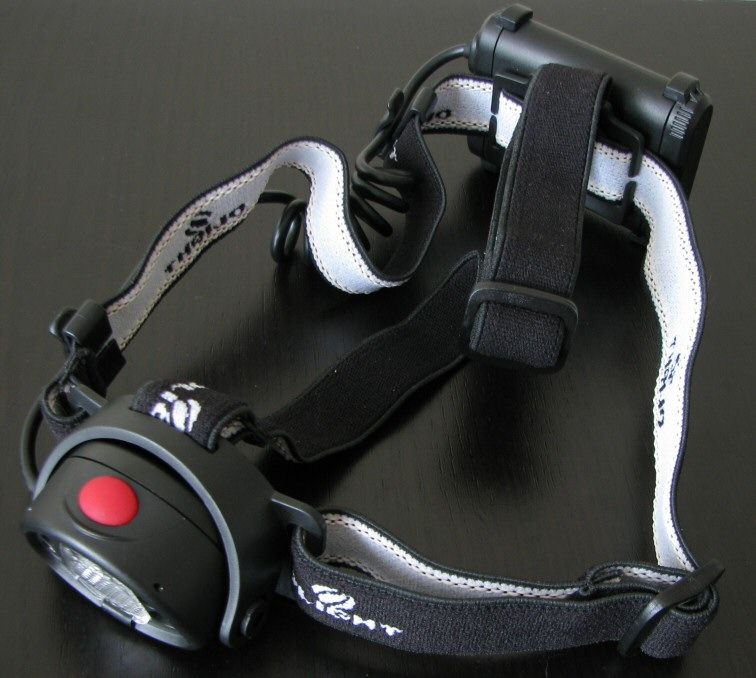
Welcome to my review of the H15 Wave headlamp, from Olight (or, I guess I should say, the H15 :wave . AFAIK, this is the first dedicated headlamp produced by Olight.
. AFAIK, this is the first dedicated headlamp produced by Olight.
I haven't posted too many headlamp reviews here, but I have worked with a reasonable number of different types and models of over the years. Most of the time outdoors, I've stuck with my Petzl Tikka XP2, or its predecessor the venerable Petzl Tikka XP (that I long ago modded with a SSC emitter). Indoors, I've tended to use my various Zebralight, Spark and ITP headlight models. I will review the H15 in those comparison terms.
Reported Manufacturer Specifications:
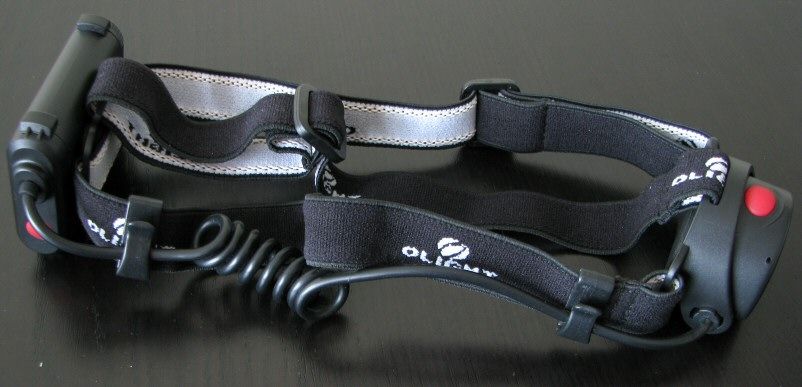
My review sample was an early release, so it doesn't have the full packaging. I don't know what accessories it comes with, but you can see a 3-piece headband is included. The straps are all easily removable.
First thing you will notice is that the battery compartment is separate from the head. There is spiral cable connecting the two (again removable from the clips on the headstrap, if you want).
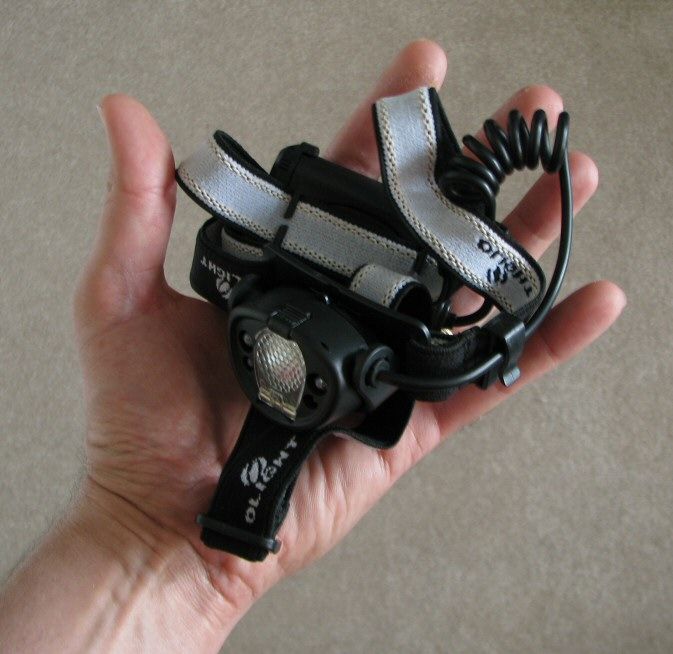
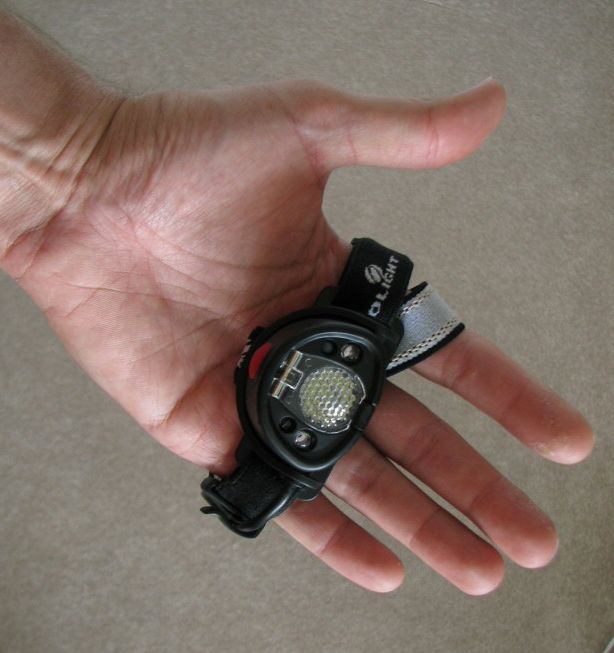

From left to right: Olight H15, Petzl Tikka XP2, Petzl Tikka XP, Zebralight SC30W, Spark ST5.
All dimensions are given with no batteries installed:
Olight H15 Wave: (4xAAA): Head alone: 42.5g, Battery compartment alone: 28.4g, Battery compartment alone with batteries: 74.8g, complete unit (with headband and batteries): 141.5g
Petzl Tikka XP (3xAAA): 58.3g, 94.4g (with batteries)
Petzl Tikka XP2 (3xAAA): 52.3g, 88.4g (with batteries)
Spark ST5 (1xAA): Weight, 41.5g, Length 58.4mm, Width 42.8mm (max body), Width 24.0mm (bezel)
ITP H01 (1xAAA): Weight: 22.7g, Length 53.7mm, Width 37.2 (max body) or 15.4mm (bezel)
Zebralight H31w (1xCR123A): Weight: 28.6g, Length 66.9mm, Width (bezel) 22.1mm.
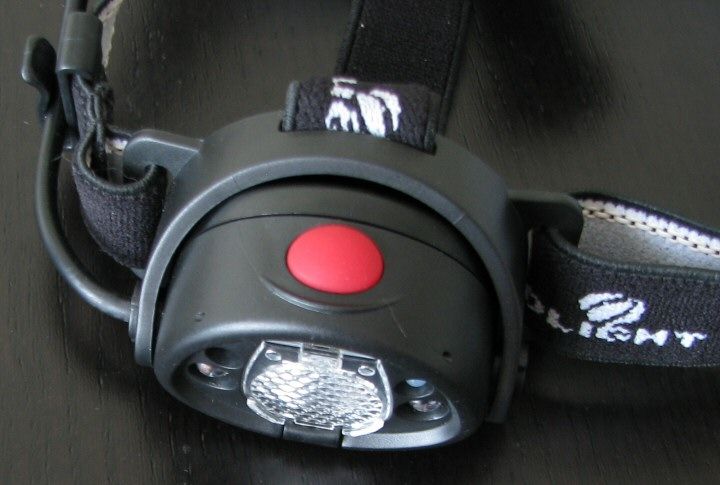
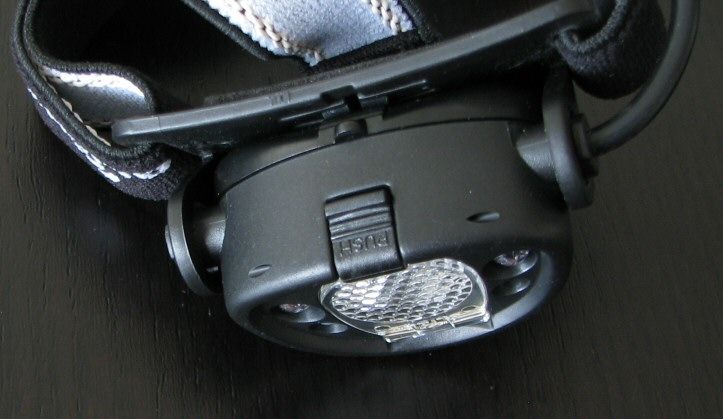
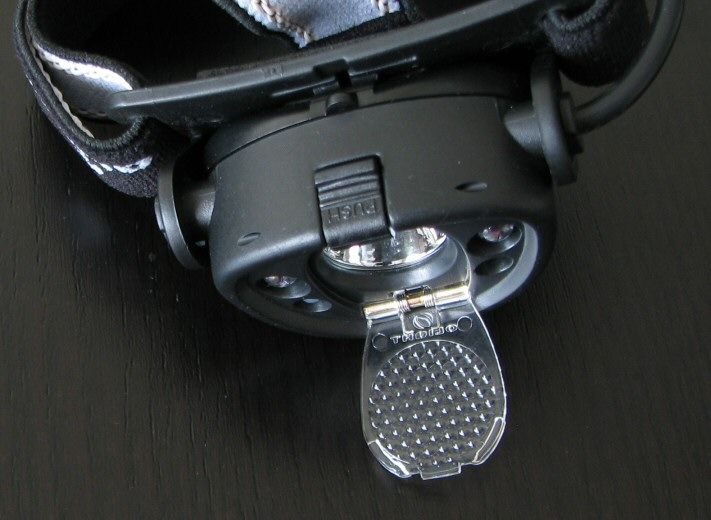
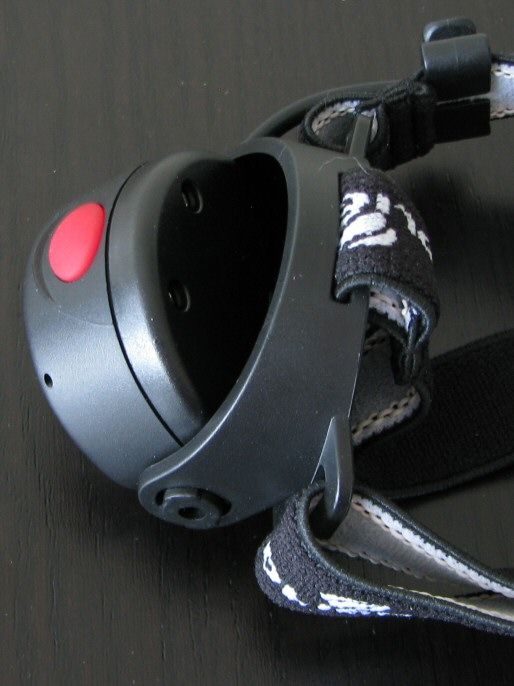
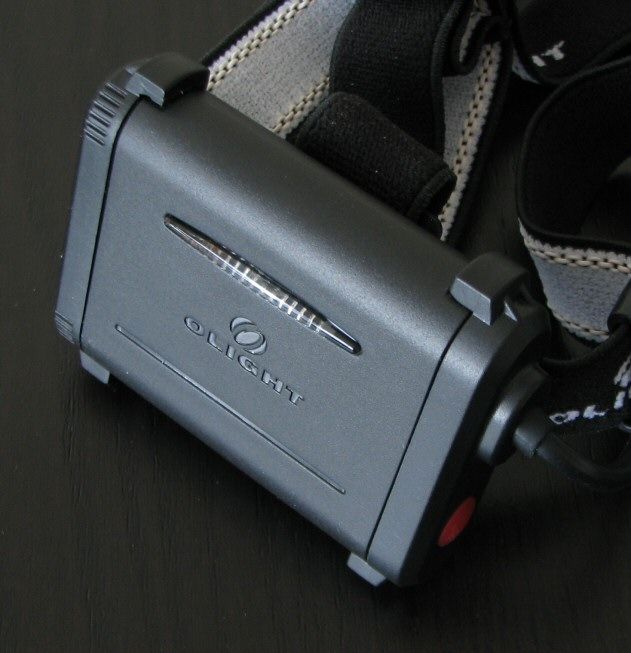
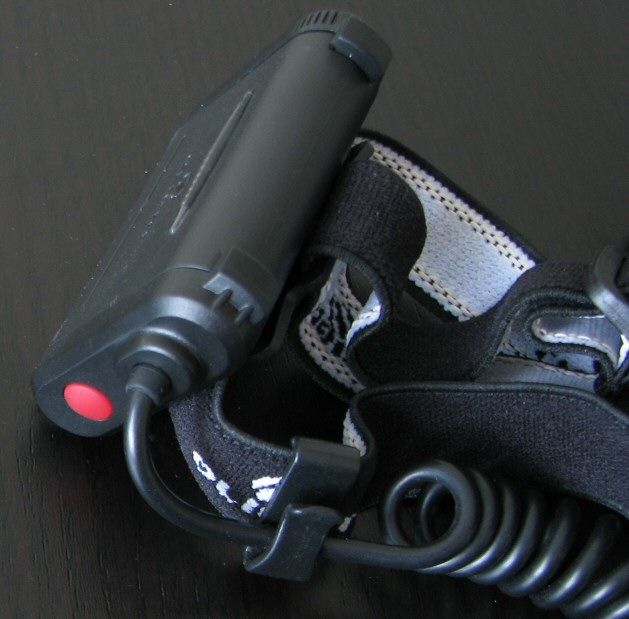
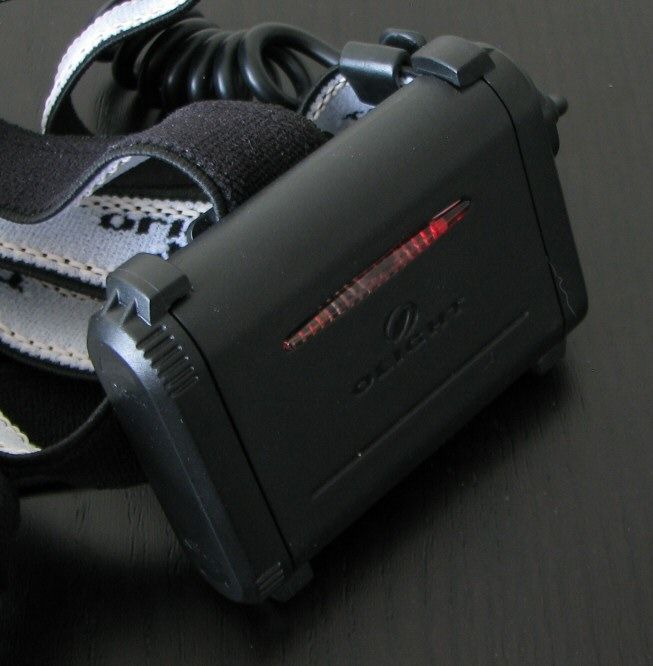
To overall shape and look of the H15 is similar to a number of headlamps, especially those using multiple AA or AAA cells. The H15 is somewhat distinctive (if that is the word ) in that it uses 4xAAA. I suspect most users would have preferred 2xAA for increased capacity with comparable weight.
) in that it uses 4xAAA. I suspect most users would have preferred 2xAA for increased capacity with comparable weight.
The H15 also separates the battery compartment from the main headlamp unit. This is not an uncommon design, and it does offer a few advantages (i.e., balances out the weight, and allows secondary signalling from the red LED on the battery case). Still, I personally prefer all-in-one solutions, as it removes the extra cabling.
Build of the headlamp and battery case is plastic, as you would expect (as is common in AA/AAA consumer headlamps).
The emitter is different from most comparably-priced consumer headlamps – you get the Cree XM-L emitter here. You also get the option for both throw and flood, thanks to a dedicated reflector and spring-mounted diffuser cover (scroll down for up-close pics and beamshots). There are also two fairly bright auxiliary red LED emitters on the front of the unit.
The battery case has a secondary (and dimmer) red light that can be used for constant on or slow-flash/beacon mode. The main off/on switch for the unit is on the battery case (scroll down for a discussion of the UI).
On the top of the front headlamp unit, you have a single large button to control modes. There are also motion-sensitive sensors on the front that can respond to hands-free "waves" to change levels. Again, see the UI discussion below.
Headband is good quality, IMO. The top-strap is easily removable (if you don't want to muss up your hair too much).
Let's take a closer look at how the batteries fit in …
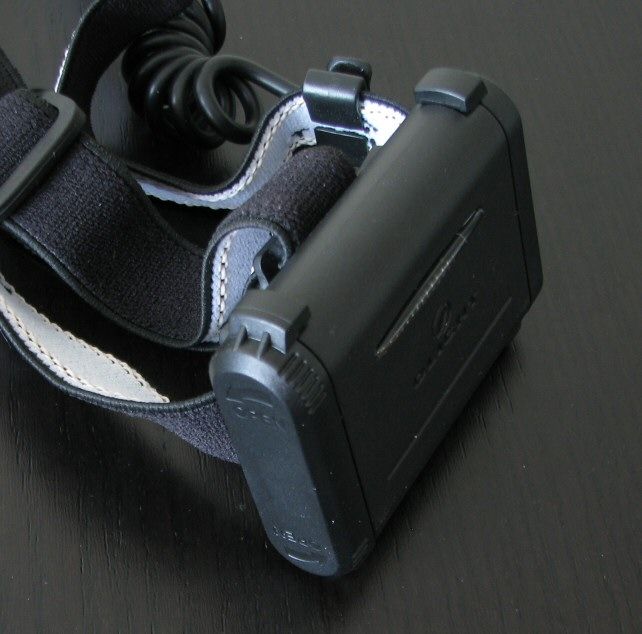
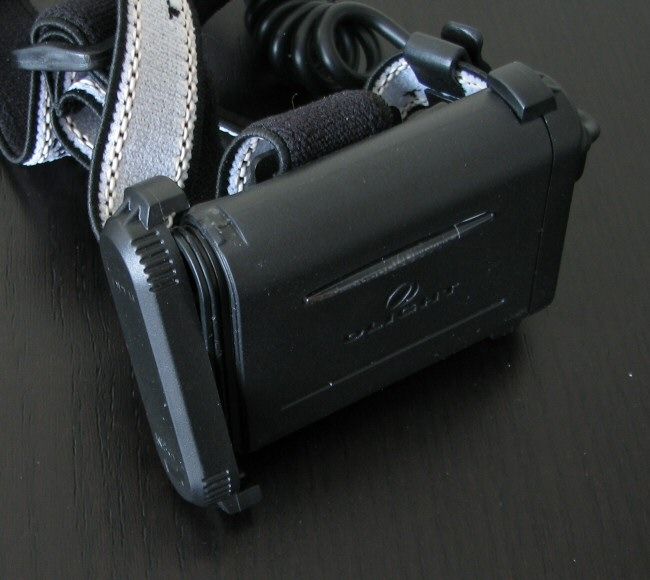

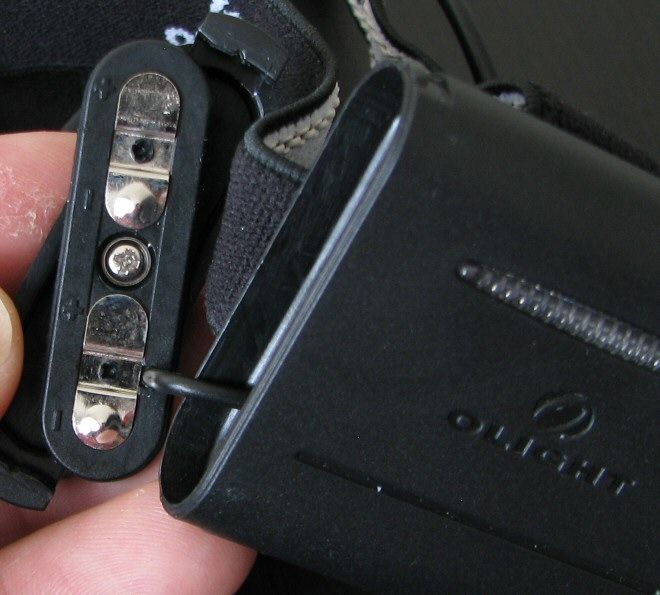
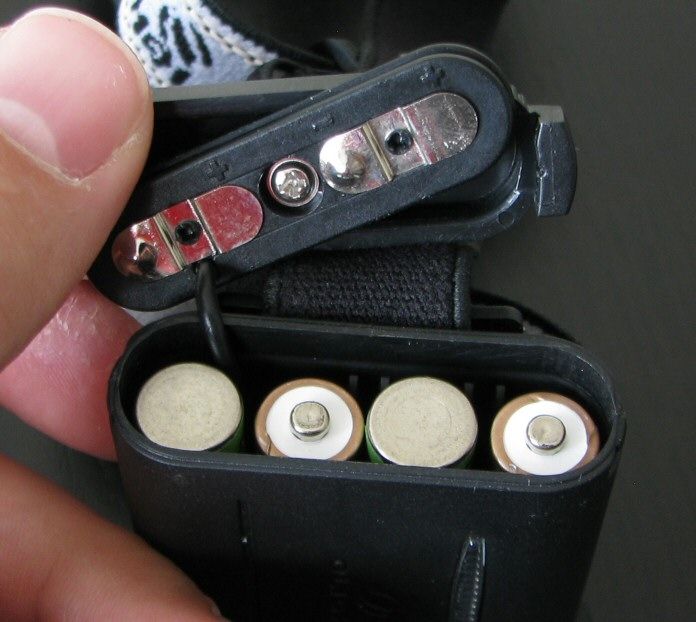
All-plastic multi-AA/AAA carriers tend to be somewhat limited in their battery hinge design and water-proofness. In the case of the H15, you rotate the designated side end-bracket until the end-piece pops open (i.e., out of the retaining clamps holding it down). There you will find an internal connection piece that swivels slightly from the end-bracket. There is an o-ring around this connection piece that helps to maintain water-proofness. There is also a connecting cable to ensure you don't lose the end piece.
Pay attention to how the batteries go in – the labels on the plastic end-bracket are very small, and hard to see. But you can tell from the indentations on the metal contacts which way the cells are supposed to go (i.e., negative battery terminal to the raised dimpled connector piece, positive battery terminal to the flat connector piece). If you put them in wrong, Olight informs me the unit does have reverse-polarity protection.
Although I find the carrier end-bracket a little fussy to re-seat and lock into place, I am more confident that it will maintain reasonable water-proofness than most other all-plastic headlamps I've handled. There is actually reasonable good tension on the end-bracket, holding it tightly closed (once you get it properly lined up).
There is actually reasonable good tension on the end-bracket, holding it tightly closed (once you get it properly lined up).
User Interface
Prepare the light for activation by the switch on the battery pack. The switch is presumably electronic, and acts as a reverse clicky (i.e., click and release to turn on).
When on, the red light on the battery pack will illuminate to a constant dim red. To change this to a slow strobe/beacon mode, press and hold the battery pack switch.
With the battery pack turned on, you activate the headlamp output modes by clicking the switch on the head of the headlamp. Modes are advanced by clicking the head switch again, in the reoccurring sequence of Standby > White LED (Lo) > Red LEDs (constant), in a repeating loop.
By default, you can the turn headlamp off/on in any given mode by a wave of the hand within 10 cm of the sensors on the front of the light (e.g. wave for off, wave again for back on).
You can switch from Lo to Hi level on the White LED mode by a rapid double-wave of the hand over the sensor. You have to do this quickly though, or you will instead turn the light off and back on in the Lo mode. Similarly, a double-wave over the red LED mode will move you into red Strobe level.
To deactivate the sensor and "lock" the given level you are in, press and hold the head switch for more than 3 secs. To re-activate the sensor, press and hold the head switch again for 3 secs, or click the switch to advance to the next mode.
There is no mode memory, and the unit always defaults to Lo white mode and constant-output red mode when accessed in sequence from the main head switch.
So, to summarize, clicking the head switch advances you between standby, white and red modes. A single wave can be used to temporarily turn off/on any given mode, and a double-wave will temporarily change the level within that mode.
There is a diffuser cover for the emitter that is spring-mounted and held in place by a small clip on the base of the head unit. Press on the clip to release the diffuser for more throw.
For information on the light, including how the wave sensor works in practice, please see my video overview:
Video was recorded in 720p, but YouTube typically defaults to 360p. Once the video is running, you can click on the configuration settings icon and select the higher 480p to 720p options. You can also run full-screen.
PWM/Strobe
There is no sign of PWM that I can see, at any output level – I presume the light is current-controlled, as claimed.
Olight reports a secondary red SOS mode (accessed by a quick double-wave when in red mode). However, this is actually a moderate strobe mode:
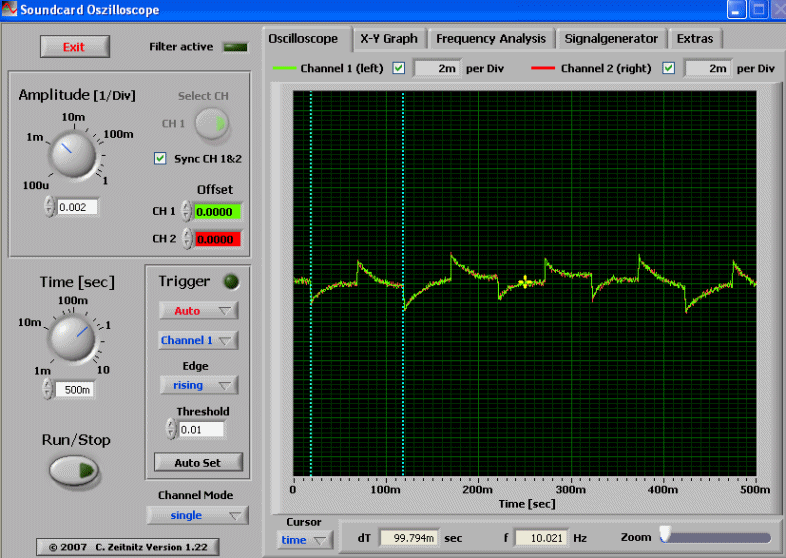
Strobe frequency was 10 Hz on this red strobe mode.
Note there is also a slow strobe/beacon mode on the battery pack red LED. The intensity is too low to detect with my sound card oscilloscope, but I timed the flashes at a rate of three times every two seconds (i.e., roughly 1.5 Hz)
Standby Drain
As both the battery pack and head switches are electronic, a standby current drain is always present when a battery is installed. Given the design of the carrier, I was not able to measure this current, however.
Beamshots:
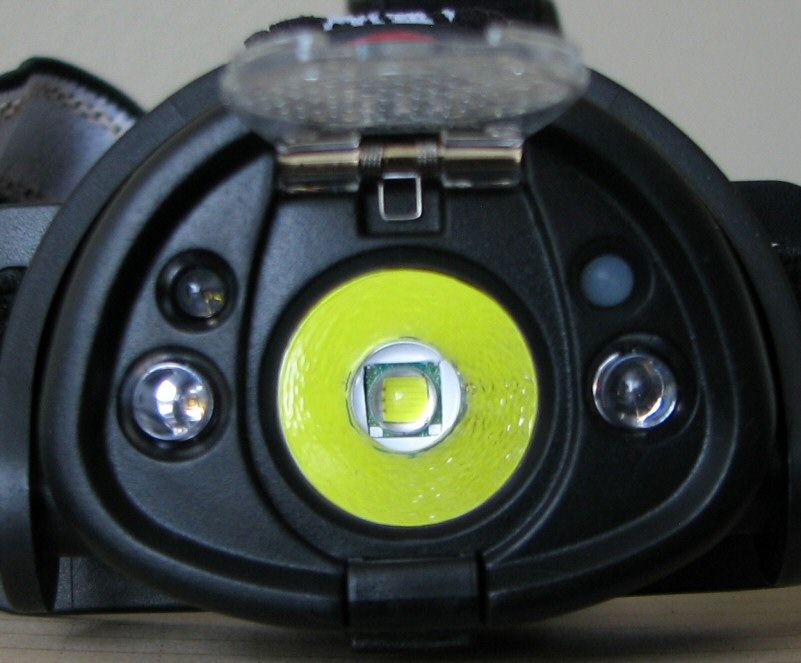
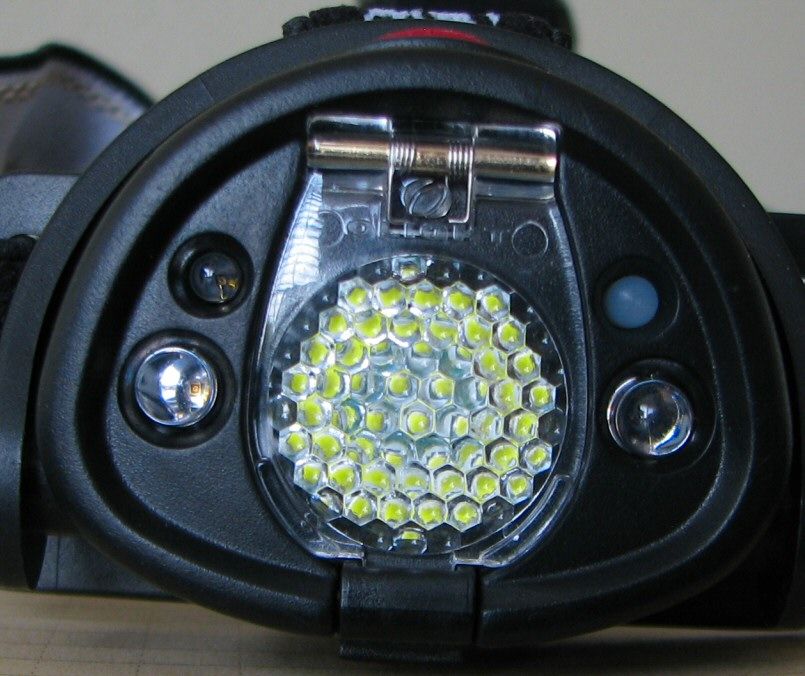

The H15 uses a cool white XM-L emitter with a lightly textured reflector (LOP). Emitter was well centered on my sample. A spring-mounted diffuser cover allows you to diffuse the beam. Although the reflector is small, it is deeper than most headlamps I have come across.
There are two red LED emitters on either side of the main white emitter. These were brighter than I've normally come across on headlamps.
And now, the white-wall beamshots. All lights are on Max output on the identified battery type. Lights are about ~0.75 meter from a white wall (with the camera ~1.25 meters back from the wall). Automatic white balance on the camera for the cool white emitters (to minimize tint differences), daylight white balance for the neutral white ST5.
All lights are on Max output on the identified battery type. Lights are about ~0.75 meter from a white wall (with the camera ~1.25 meters back from the wall). Automatic white balance on the camera for the cool white emitters (to minimize tint differences), daylight white balance for the neutral white ST5.
Let's start with un-diffused white beams. Note for the SSC-modded Tikka XP, these beamshots are for the Hi mode (not the momentary Burst mode).
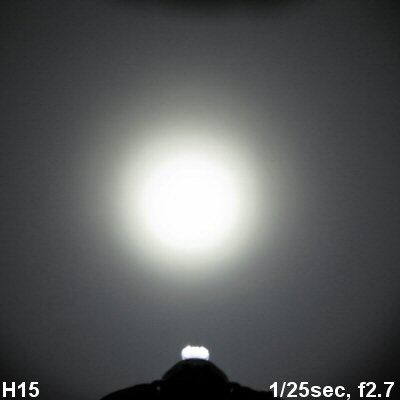
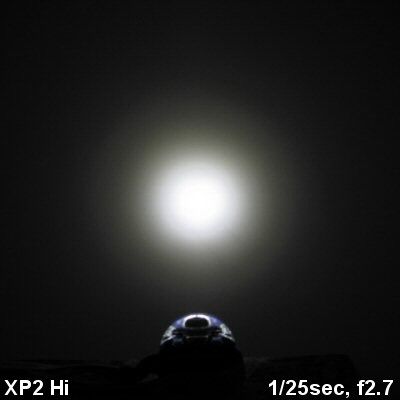
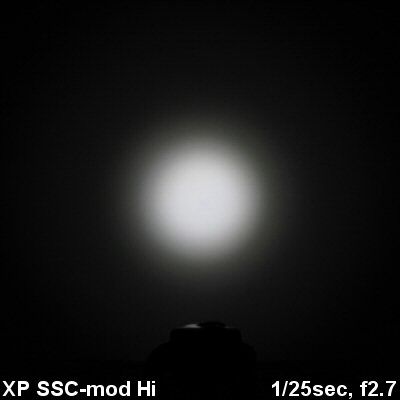
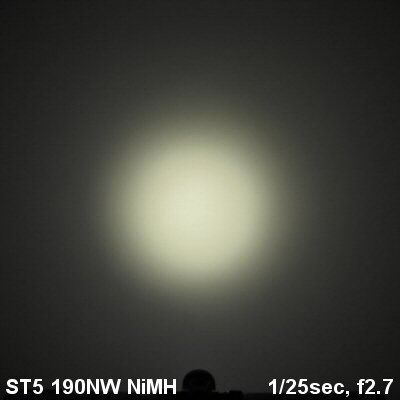
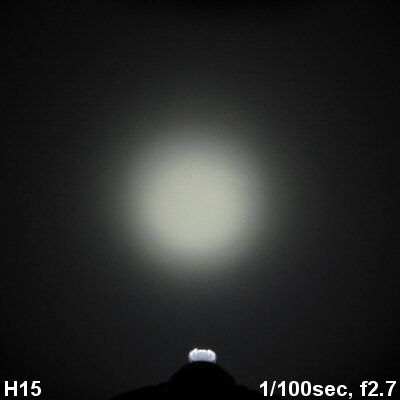
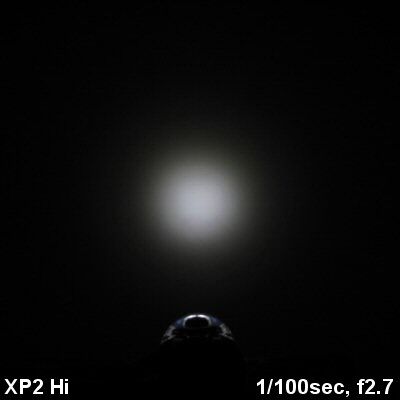
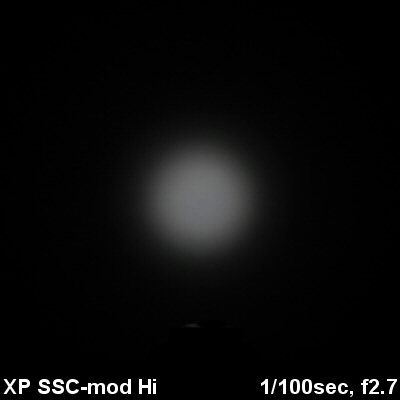
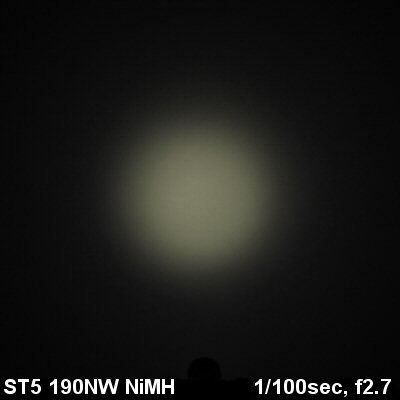
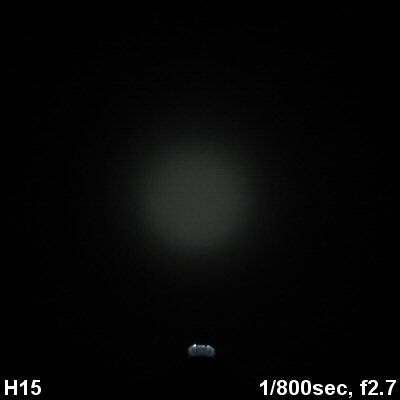
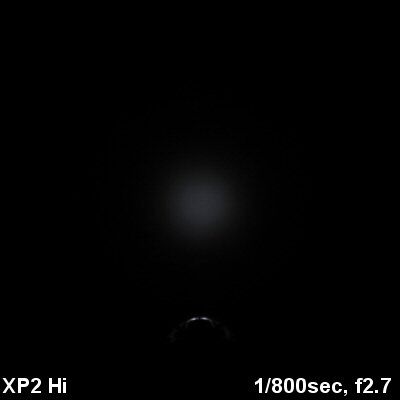
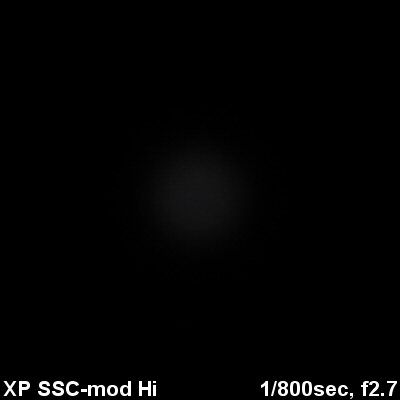
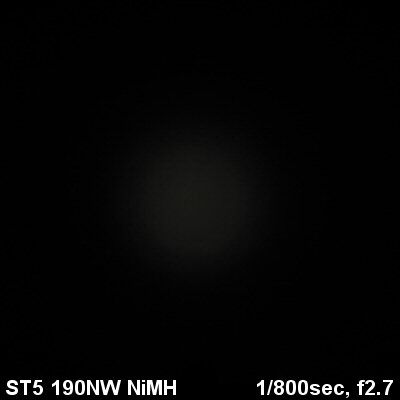
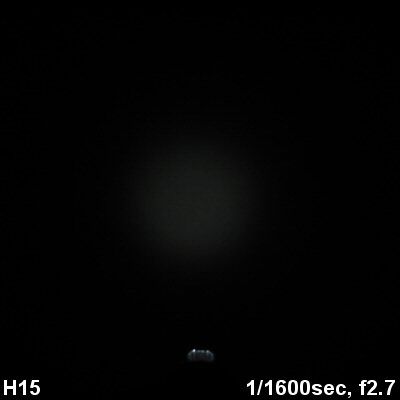
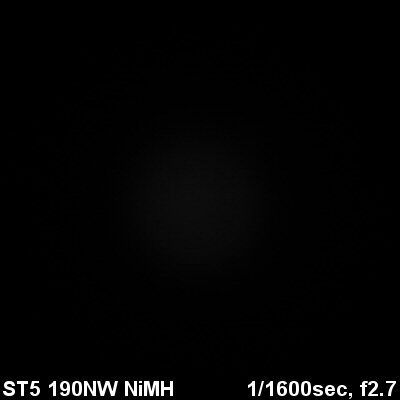
The H15 gives a pattern similar to other reflector-based XM-L lights, like the Spark ST5 shown above. Lights that use an optic (e.g., the XP-E-based Petzl Tikka XP2, or my SSC-modded Tikka XP) tend to have a narrower beam profile with less spill. They also sometimes have color distortions in the beam (e.g., the stock Tikka XP2).
Now let's see what happens with included diffuser in place on all of the above lights:
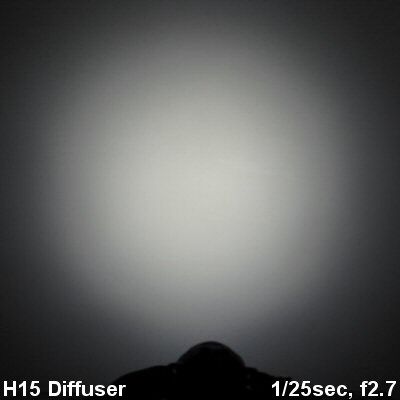
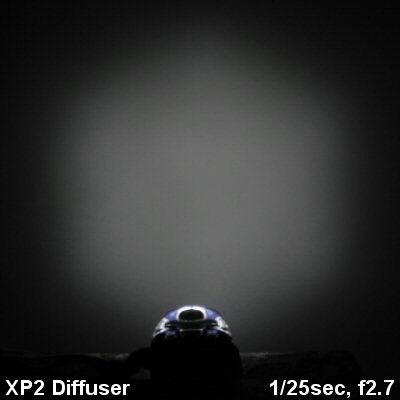
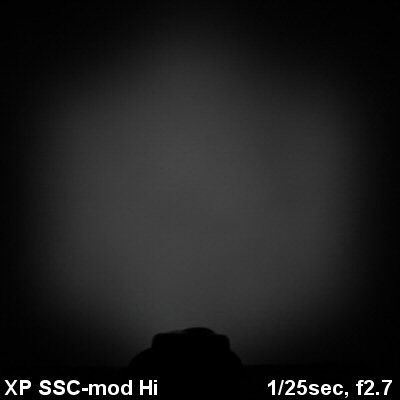
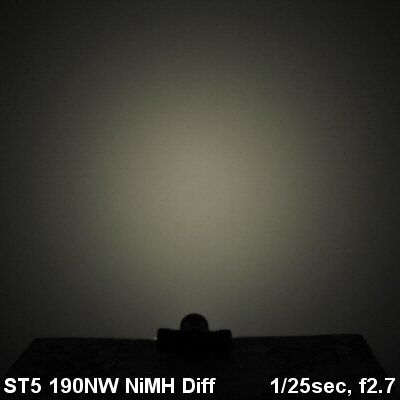
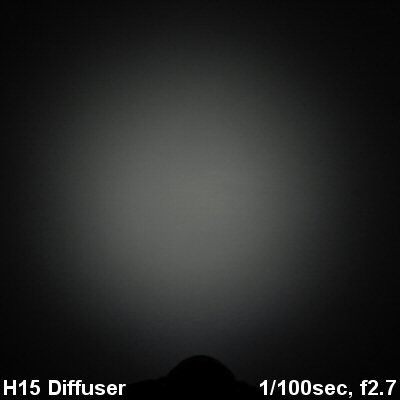
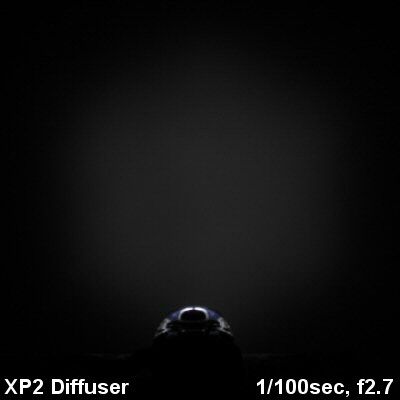
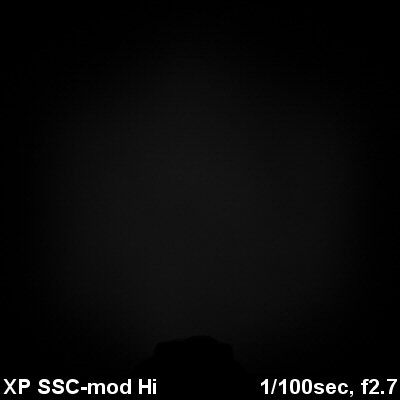
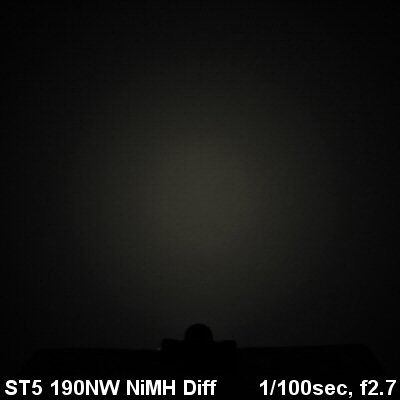
The H15 diffuser does a good job diffusing the beam. :thumbsup:
And now the red beam shots. Note that the original Tikka XP didn't have a red LED, but Petzl did sell various colored diffuser covers. Shown below is my SSC-modded XP with a red diffuser cover (on Hi).
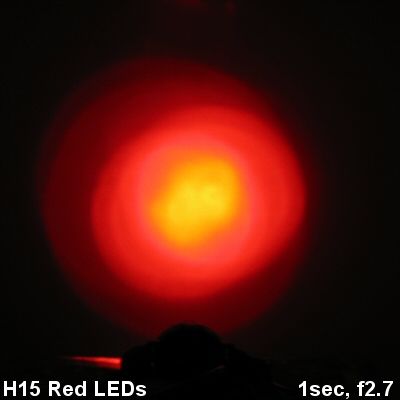
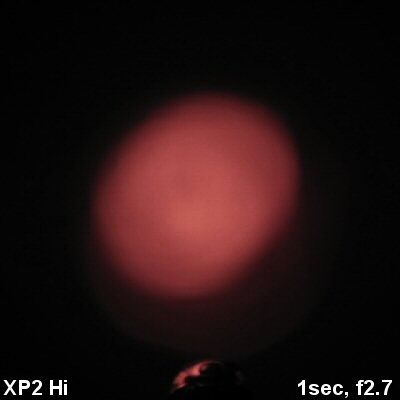
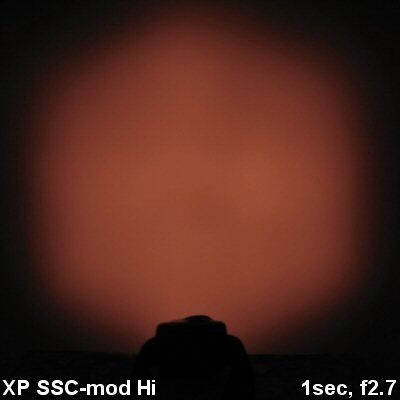
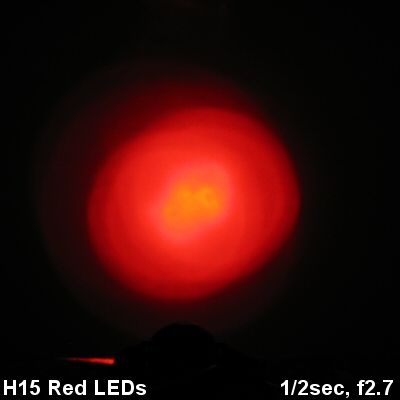
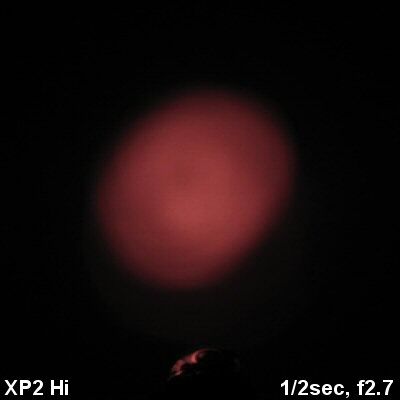
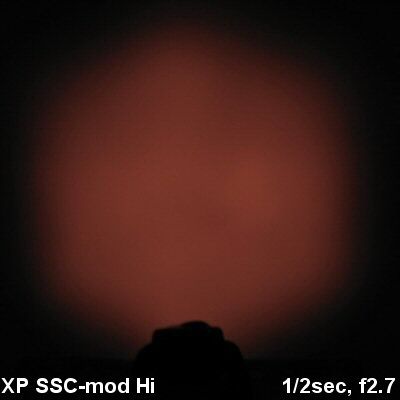
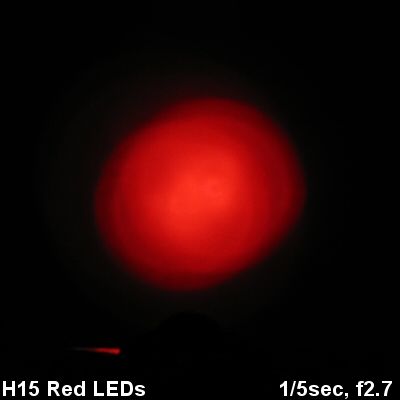
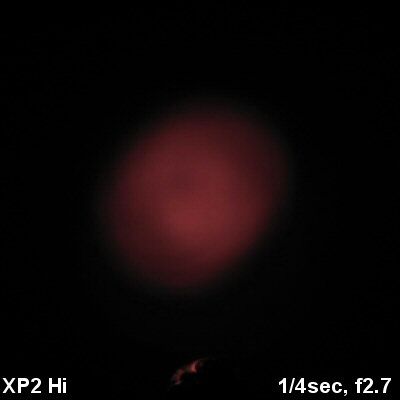
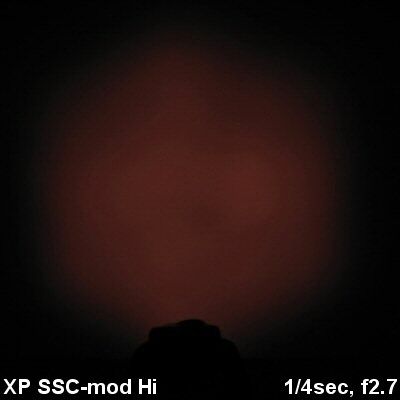
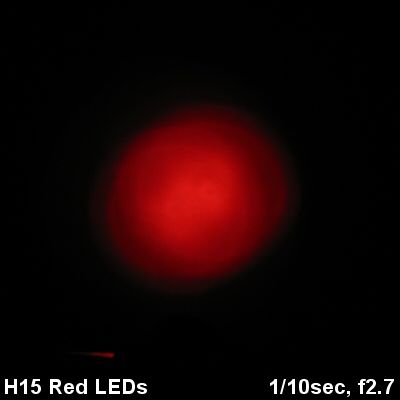
Again, you can see the red light emitters on the H15 are quite bright. Scroll down for a direct output measurement.
As useful as the above shots are, I know people like to have a better idea of the beam angle coming out of the headlamp. So for that, I have turned to my famed "integrating carpet."
First, the un-diffused beams (the beam tint is a little off on the H15, due to inclusion of the neutral-white ST5 in the same pic, with camera set to auto-white balance):
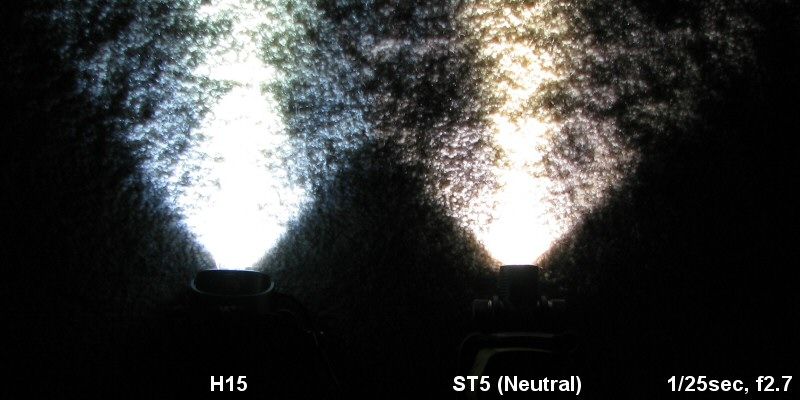
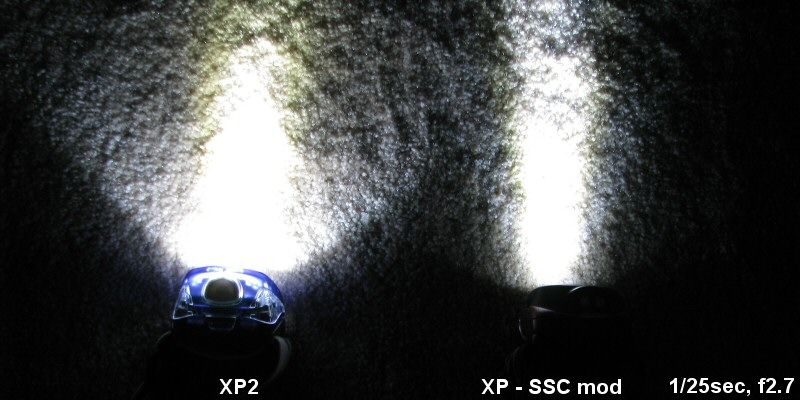
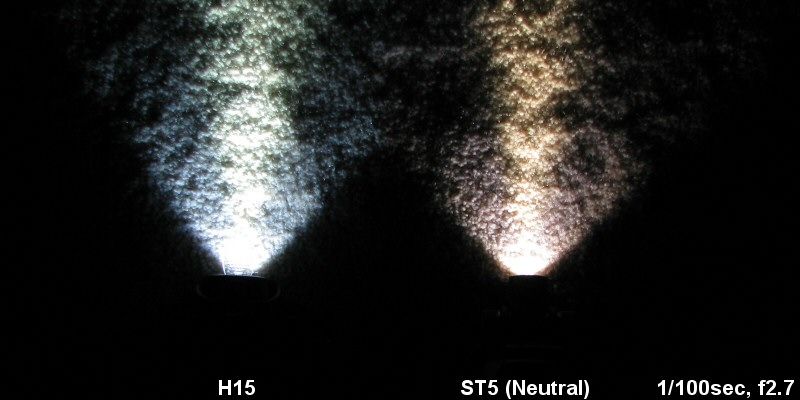
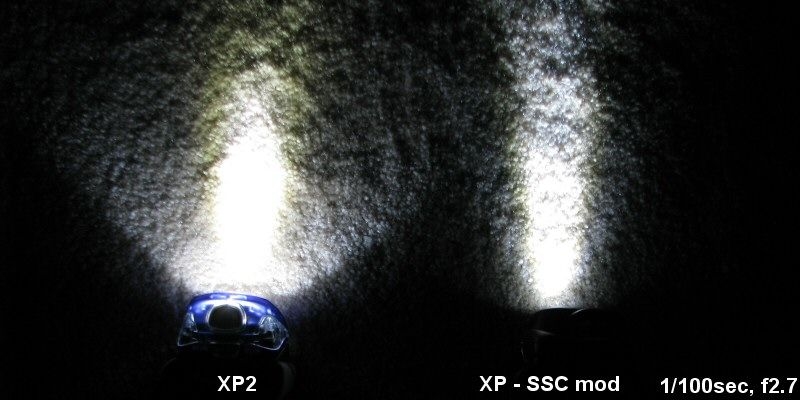
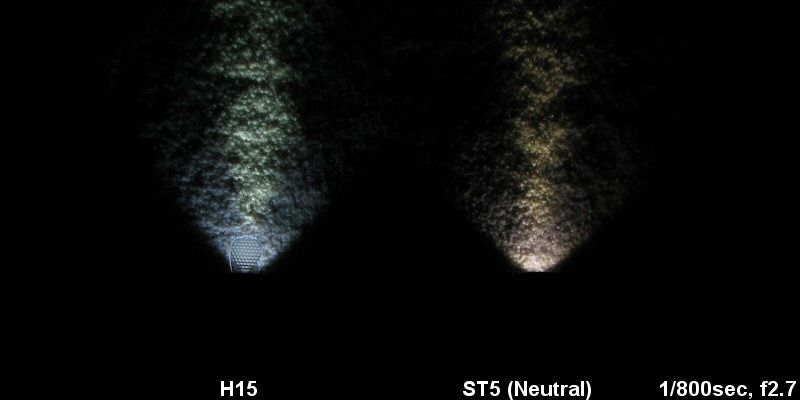
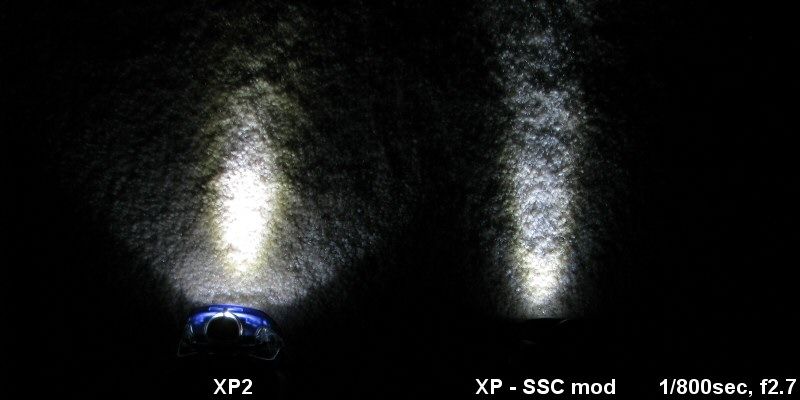
The H15 has a fairly typical pattern for a reflectored light. As you can see, the optic of the original Tikka XP can't be beat for a spill-free beam. Also, notice the prominent color distortions in the beam of the XP2 (i.e. a very yellowish corona). :green:
And now, with diffuser:
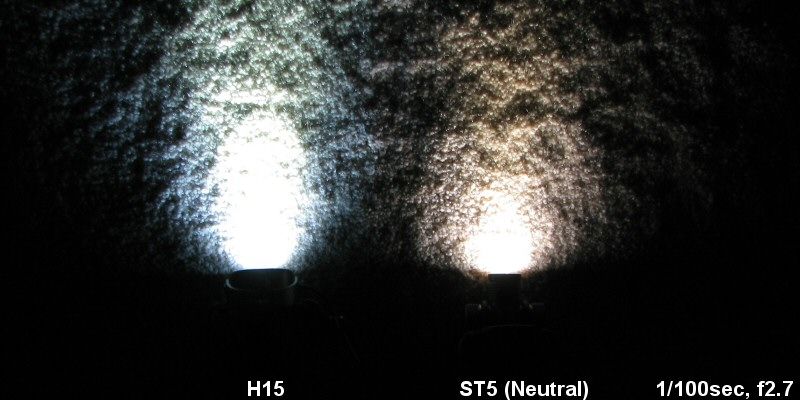
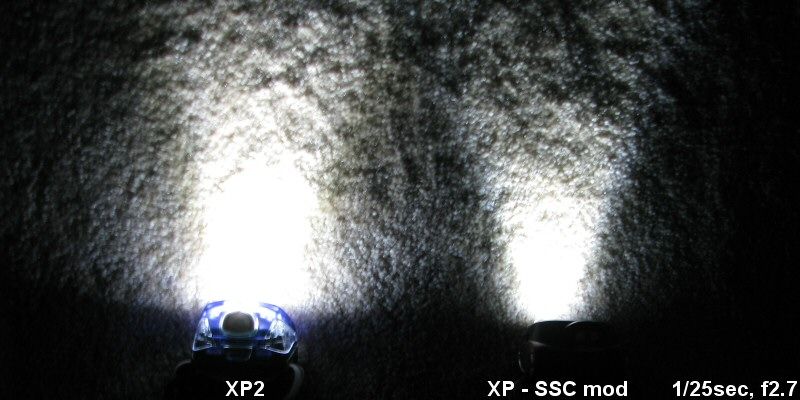
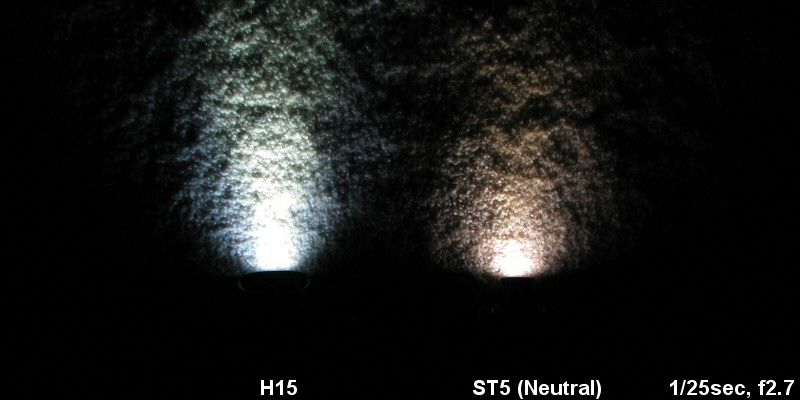
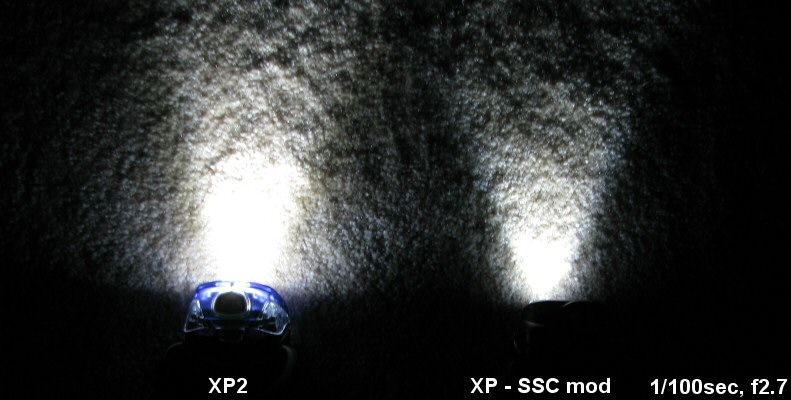
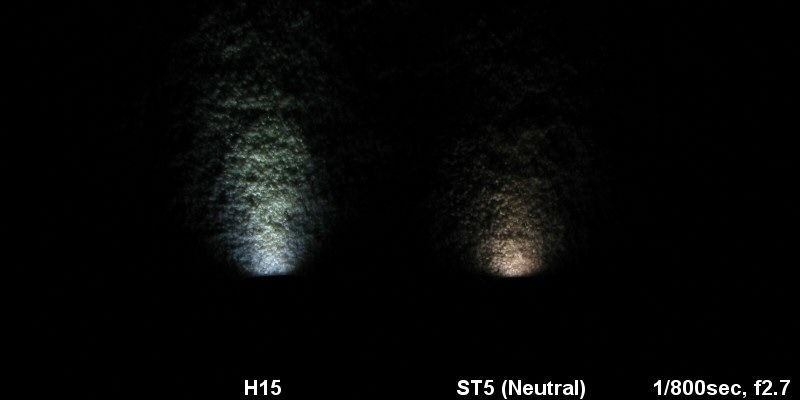
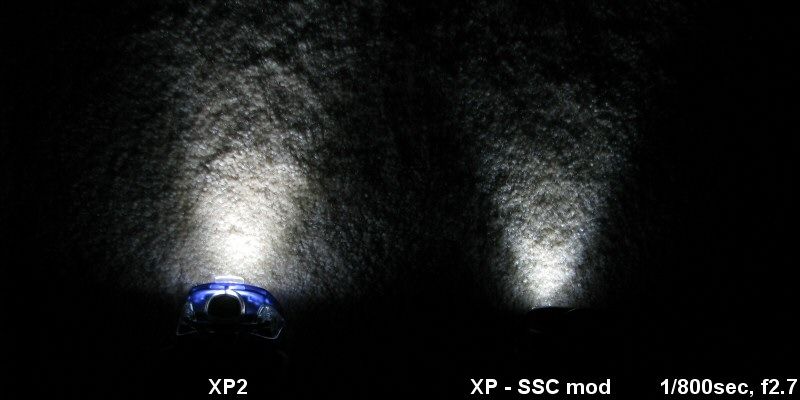
Again, no surprises for the H15, a typical diffuse beam. The Tikka XP2 is definitely a good choice if you want the widest beam possible (the diffuser also helps even out the color distortions somewhat) Still tough to beat my old SSC-modded original XP for the widest choice of beam profile choice.
Before I move on, one comment here about the flip-up diffuser on the H15 – it tends to cast something of a shadow on the spillbeam. You couldn't really see it on the beamshots up above, so I thought I would take a zoomed out pic of full white wall beamshot:
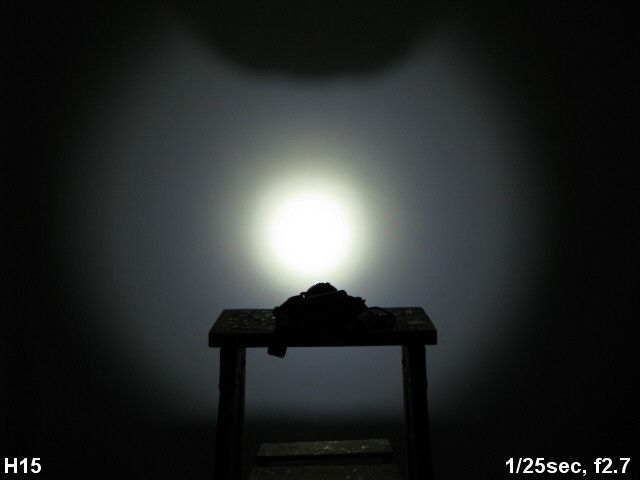
You can see the shadow it casts above.
The lights are all sitting on top of a step-ladder for these white wall beamshots, in case you were wondering.
Testing Method:
All my output numbers are relative for my home-made light box setup, a la Quickbeam's flashlightreviews.com method. You can directly compare all my relative output values from different reviews - i.e. an output value of "10" in one graph is the same as "10" in another. All runtimes are done under a cooling fan, except for any extended run Lo/Min modes (i.e. >12 hours) which are done without cooling.
I have devised a method for converting my lightbox relative output values (ROV) to estimated Lumens. See my How to convert Selfbuilt's Lightbox values to Lumens thread for more info.
Throw/Output Summary Chart:
My summary tables are reported in a manner consistent with the ANSI FL-1 standard for flashlight testing. Please see http://www.flashlightreviews.ca/FL1.htm for a discussion, and a description of all the terms used in these tables.
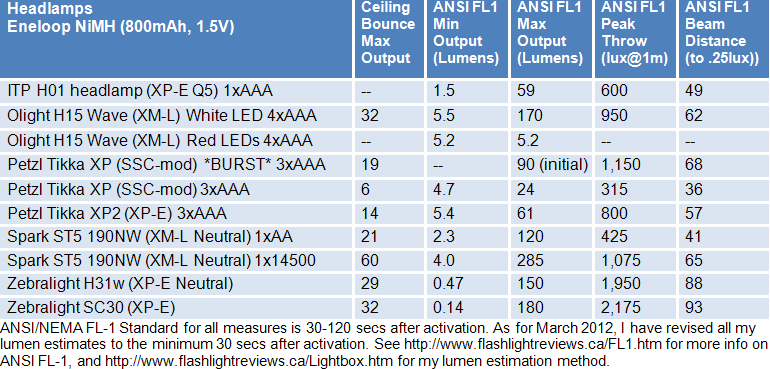
Olight reports 150 lumens Hi and 5 lumens Lo on the white LED, and 4 lumens on the red LEDs. As you can see in my table, these numbers are not very far off from my estimates. :thumbsup:
The Beam Intensity/Distance measures also seem very accurate to Olight specs (i.e., I know my standard lightmeter tends to under-report slightly, compared to most others).
FYI, the red LED on the battery pack is quite dim in comparison to the front-mounted ones (i.e., a little under <0.001 estimated lumens in my testing). It is enough to provide an on/off signal in the complete dark, but not much more.
Output/Runtime Comparison:
To start, I thought I would show you the performance to my two 3xAAA headlamps, and a recent 3xAAA flashlight:
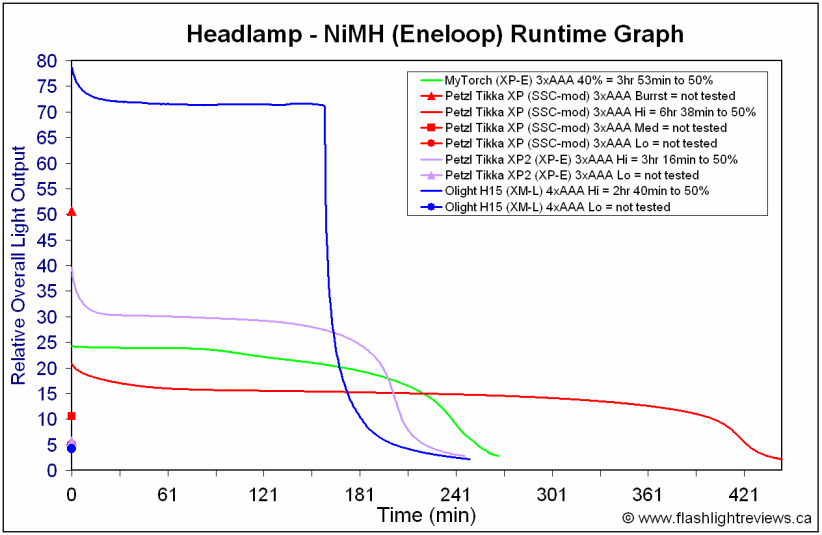
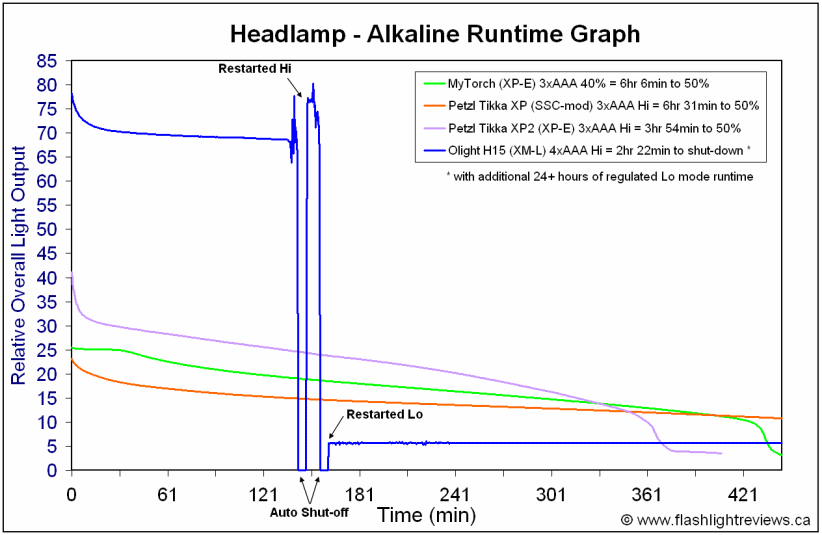
The H15 clearly has a lot more output on Hi than these other lights with older emitters. oo: Runtimes seem quite good for the output and 4xAAA battery source. Again, my findings are quite consistent with the reported Olight ANSI FL-1 standard specs (note the standard defines runtime as time to 10% initial output).
oo: Runtimes seem quite good for the output and 4xAAA battery source. Again, my findings are quite consistent with the reported Olight ANSI FL-1 standard specs (note the standard defines runtime as time to 10% initial output).
One issue you may observe here is the lack of a Med mode (i.e., the Lo mode of the H15 is very consistent with the Lo mode of my other multi-mode headlamps).
You will also notice something peculiar on the alkaline Hi mode runtime above. :thinking: After about 2hr and 20 mins into the run, the output level began to fluctuate slightly. The light then shut-off completely. After a few mins rest, I reactivate on Hi, and saw several more minutes of slightly fluctuating Hi output before the light shut-off again. I then re-activated on Lo, and got more than 24 hours of regulated Lo mode runtime.
It would seem that as the alkaline cells are no longer able to supply regulated Hi output, the light shuts off rather than simply drop down to Lo. Not really a problem per se, as you can simply re-activate in Lo (or maybe a few more mins of Hi), but it is unusual. :shrug:
Let's see how the H15 compares to a 1xAA headlamps. I don't have the Zebralight H51 headlamp, but performance should be comparable the SC51 presented below.
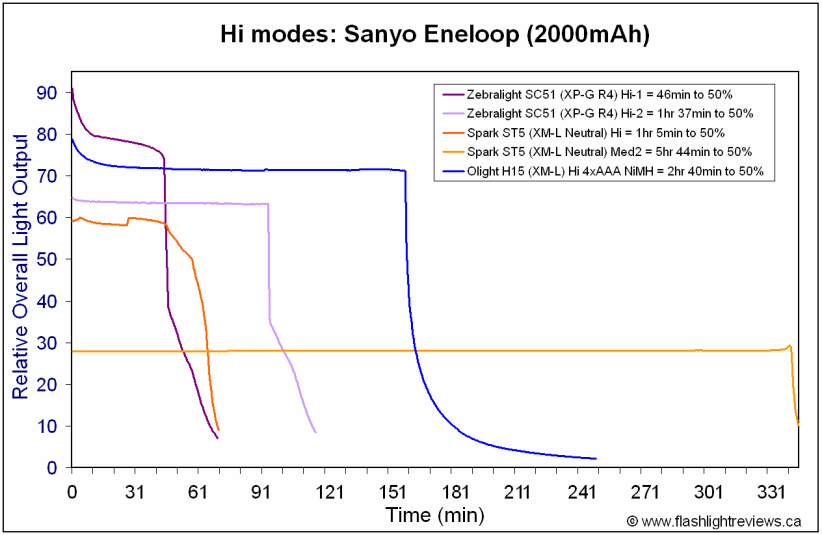
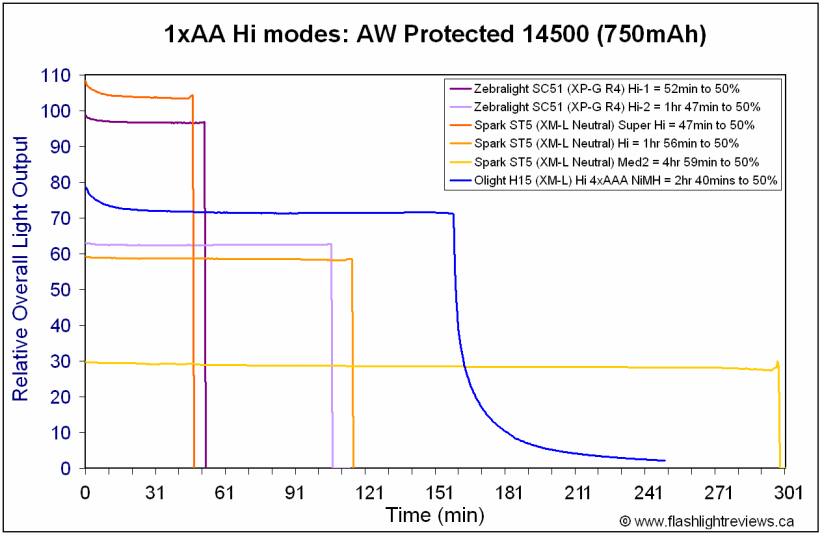
The H15's Hi output level is in keeping with other well-driven single AA-based lights. Runtime is longer of course, because of the 4xAAA capacity.
Of course 1xCR123A/RCR/14500 headlights would be expected to be brighter on Hi. You can see this in the 1x14500 output/runtime graphs above.
Potential Issues
The wave switch timing takes a fair amount of getting used to for mode level changes (i.e., you have to be very quick on the double-wave to switch from Lo to Hi in white, or constant to strobe in red). Unfortunately, it is also rather sensitive for simple on-off. As I discuss in the video overview, I found that I could easily accidentally turn the light off by simply passing too close to a door jam, cabinet door, counter-top, etc. You are likely to want to temporarily lock-out the wave feature when working with the light indoors.
Pressing the mode sequence switch on the head always advances you through Standby > White LED > Red LEDs, in sequence. However, you can turn it off/on at the battery pack as well (always comes back on in Standby mode). There is no mode memory, and the light always defaults to Lo White and constant Red levels in the sequence.
The light uses a separate battery compartment connected to the headlamp by a coiled cable. It also uses 4xAAA cells.
Due to the electronic switches, a standby current will always be required when batteries are installed. I have not measured this current, however.
All headlights that use a plastic battery carrier typically have limitations in terms of water-proofness. In this regard, the design of the H15 seems better than other plastic 3xAAA headlamps I've used (but can be a bit fussy to line-up correctly when installing batteries).
When the diffuser is not in place over the beam, it sticks out at a 90-degree angle from the front of the unit. This casts a minor shadow over the top of the spillbeam.
The light lacks a defined Medium mode (i.e., just Hi and Lo).
I am not sure what final packaging will include, but the bundled headband seems of good quality for this type of light.
Preliminary Observations
The headlamp space is a new departure for Olight, with the launch of their inaugural H15 Wave. :wave:
To be honest, this is a difficult space to do well. People have very differing needs in a headlamp, and it is probably impossible to have one design that pleases everyone, all of the time. I personally have gone through quite a few different models over the years – and continue to keep several models around for use in different situations and for different purposes.
Opinions obviously vary about the value of separate battery packs, all-plastic construction, and the use of multiple AAA-sized cells. I will leave that up to personal preference and focus on the specific feature set and user interface in most of my comments below. But I will make the general point that the H15 seems relatively well-built, within the specific design choices made. For example, the tension on the battery pack bracket cover is good, and there is an o-ring in there. I would expect water-proofness to be higher than most of my 3xAAA plastic headlamps (although the bracket can be a bit tricky to seat properly, until you get the hang of it).
I will leave that up to personal preference and focus on the specific feature set and user interface in most of my comments below. But I will make the general point that the H15 seems relatively well-built, within the specific design choices made. For example, the tension on the battery pack bracket cover is good, and there is an o-ring in there. I would expect water-proofness to be higher than most of my 3xAAA plastic headlamps (although the bracket can be a bit tricky to seat properly, until you get the hang of it).
What is particularly novel about the H15 is the control interface, especially the wave feature. While the option to have hands-free operation is interesting, I actually found it rather limiting in practice. It often takes a couple of tries to accurately switch levels within a given mode (through the double-wave), and it can be too easy to accidentally shut the light off by passing you head near an object (i.e. the single-wave). Indoors, I found I frequently had to reach up and lock out the wave feature to prevent accidental deactivation, negating the benefit of a hands-free level change. :shrug:
Personally, I am not crazy about the main UI – specifically, having to activate at the battery pack first (which brings you into standby mode), then always switch thorough Lo white, constant red, and standby again (in sequence) from the front switch. It's true you can jump back to standby by turning off-on at the rear (i.e., if you want to avoid red), but you still have to switch on at the front for Lo white. And if you want to activate in red from off, you are out of luck – you need to switch past Lo white first (unless you just temporarily waved off/on in red mode). There's also no memory for the Hi white or strobing red levels.
In terms of the actual beam, the white LED beam pattern is quite good, in keeping with the reflectored nature of headlamp. The diffuser also does a good job spreading out the beam for up-close work, although it is a little peculiar to always have it sticking out when not in use. At least you don't have to worry about losing the diffuser, but I would have preferred a sliding mechanism.
Hi white output is surprisingly bright for an AAA-based headlamp, and Lo mode is reasonable. Output/runtime efficiency seems quite good on Hi, and the Olight ANSI FL-1 specs definitely seem accurate for output, runtime and beam intensity/distance. But I find I missed the option for a true Med mode (i.e., when working under a sink or inside a light fixture/wall, I find 30-50 lumens can be the sweet spot).
One thing I really liked about the H15 was its selection of red light modes – specifically, the relatively bright and throwy red LEDs on the front, and the dim red LED on the battery pack.
I find most headlamps that even bother to include red light do so as an afterthought. Frankly, a single woefully-underpowered 5mm LED on most headlamps really isn't very useful as anything other than a simple moonlight. It is certainly not much help for navigation in the dark – with most red LED headlamps, I typically have to walk around slowly, starting directly at feet, to be able to make out much of anything. In contrast, the front-mounted dual D5.0 red LEDs on the H15 cast a pretty strong beam several meters ahead, along you to walk at a good clip. :twothumbs
While I'm not a big fan of separate battery compartments, the secondary red LED on the battery pack is a good idea (as is its slow beacon mode). While not very bright, it does at least provide some signaling use off the back of your head (e.g., if you were riding a bike, etc.). Personally, I would prefer to see the same slow beacon frequency duplicated on the front red LEDs as well (although I know some like a more rapid strobe indicator - as currently used on the front here).
Ok, I think this review has gotten long enough. :sweat: Bottom line, like most headlamps, the H15 has some nice features, some neutral/ok features, and some annoyances (according to my personal preferences). The question – as always – is does it have the right balance for the things you need it for? I hope this review was able to give you enough information to decide for yourself.
Personally, I don't think I'll be grabbing the H15 the next time I have to fix a leaky faucet – but I will definitely take it with me the next time I head out along those wooded walking paths I follow for my outdoor evening beamshots.
UPDATE OCTOBER 10, 2013: This headlamp has been replaced by a new model, the H15S (XM-L2, 1xLi-ion, 4xAAA). Please see my review of the currently shipping version of this light.
----
H15 was supplied by Olight for review.
UPDATE OCTOBER 10, 2013: This headlamp has been replaced by a new model, the H15S (XM-L2, 1xLi-ion, 4xAAA). Please see my review of the currently shipping version of this light.

Welcome to my review of the H15 Wave headlamp, from Olight (or, I guess I should say, the H15 :wave
I haven't posted too many headlamp reviews here, but I have worked with a reasonable number of different types and models of over the years. Most of the time outdoors, I've stuck with my Petzl Tikka XP2, or its predecessor the venerable Petzl Tikka XP (that I long ago modded with a SSC emitter). Indoors, I've tended to use my various Zebralight, Spark and ITP headlight models. I will review the H15 in those comparison terms.
Reported Manufacturer Specifications:
- Dual light sources: primary white light source uses Cree XM-L LED, while red auxiliary light source uses 2 pcs D5.0 LEDs.
- Two brightness levels for white light: High mode: 150lm/3h (Without diffuser) -- 127lm/3h (With diffuser); Low mode: 5lm/72h (Without diffuser) -- 4.2lm/72h (With diffuser).
- Two modes for auxiliary (red) light source: Normal brightness: 4lm/60h; SOS mode: 4lm/220h (reviewer note: this is actually a moderate strobe mode, not SOS)
- Uses 4xAAA batteries
- Peak Beam Intensity: 1050cd (primary white LED), 52cd (auxillary red LEDs)
- Maximum throw: 65m (primary white LED), 14.5m (auxillary red LEDs)
- Non-contact gesture control function, with advanced infrared sensor set
- Special designed diffuser for short range lighting.
- Ribbon indicator, can be set to strobe signal instruction.
- Lens: Tough ultra-clear tempering glass, with anti-reflective coating
- Split battery design can effectively reduce the weight-bearing
- Water resistant: IPX6
- Anti battery reverse protection
- Impact resistant to 1m
- Dimensions: 70mm/2.57" (L) * 53mm/2.10" (D)
- Weight: 94g/3.32oz (excluding battery)
- MSRP: ~$40

My review sample was an early release, so it doesn't have the full packaging. I don't know what accessories it comes with, but you can see a 3-piece headband is included. The straps are all easily removable.
First thing you will notice is that the battery compartment is separate from the head. There is spiral cable connecting the two (again removable from the clips on the headstrap, if you want).



From left to right: Olight H15, Petzl Tikka XP2, Petzl Tikka XP, Zebralight SC30W, Spark ST5.
All dimensions are given with no batteries installed:
Olight H15 Wave: (4xAAA): Head alone: 42.5g, Battery compartment alone: 28.4g, Battery compartment alone with batteries: 74.8g, complete unit (with headband and batteries): 141.5g
Petzl Tikka XP (3xAAA): 58.3g, 94.4g (with batteries)
Petzl Tikka XP2 (3xAAA): 52.3g, 88.4g (with batteries)
Spark ST5 (1xAA): Weight, 41.5g, Length 58.4mm, Width 42.8mm (max body), Width 24.0mm (bezel)
ITP H01 (1xAAA): Weight: 22.7g, Length 53.7mm, Width 37.2 (max body) or 15.4mm (bezel)
Zebralight H31w (1xCR123A): Weight: 28.6g, Length 66.9mm, Width (bezel) 22.1mm.







To overall shape and look of the H15 is similar to a number of headlamps, especially those using multiple AA or AAA cells. The H15 is somewhat distinctive (if that is the word
The H15 also separates the battery compartment from the main headlamp unit. This is not an uncommon design, and it does offer a few advantages (i.e., balances out the weight, and allows secondary signalling from the red LED on the battery case). Still, I personally prefer all-in-one solutions, as it removes the extra cabling.
Build of the headlamp and battery case is plastic, as you would expect (as is common in AA/AAA consumer headlamps).
The emitter is different from most comparably-priced consumer headlamps – you get the Cree XM-L emitter here. You also get the option for both throw and flood, thanks to a dedicated reflector and spring-mounted diffuser cover (scroll down for up-close pics and beamshots). There are also two fairly bright auxiliary red LED emitters on the front of the unit.
The battery case has a secondary (and dimmer) red light that can be used for constant on or slow-flash/beacon mode. The main off/on switch for the unit is on the battery case (scroll down for a discussion of the UI).
On the top of the front headlamp unit, you have a single large button to control modes. There are also motion-sensitive sensors on the front that can respond to hands-free "waves" to change levels. Again, see the UI discussion below.
Headband is good quality, IMO. The top-strap is easily removable (if you don't want to muss up your hair too much).
Let's take a closer look at how the batteries fit in …





All-plastic multi-AA/AAA carriers tend to be somewhat limited in their battery hinge design and water-proofness. In the case of the H15, you rotate the designated side end-bracket until the end-piece pops open (i.e., out of the retaining clamps holding it down). There you will find an internal connection piece that swivels slightly from the end-bracket. There is an o-ring around this connection piece that helps to maintain water-proofness. There is also a connecting cable to ensure you don't lose the end piece.
Pay attention to how the batteries go in – the labels on the plastic end-bracket are very small, and hard to see. But you can tell from the indentations on the metal contacts which way the cells are supposed to go (i.e., negative battery terminal to the raised dimpled connector piece, positive battery terminal to the flat connector piece). If you put them in wrong, Olight informs me the unit does have reverse-polarity protection.
Although I find the carrier end-bracket a little fussy to re-seat and lock into place, I am more confident that it will maintain reasonable water-proofness than most other all-plastic headlamps I've handled.
User Interface
Prepare the light for activation by the switch on the battery pack. The switch is presumably electronic, and acts as a reverse clicky (i.e., click and release to turn on).
When on, the red light on the battery pack will illuminate to a constant dim red. To change this to a slow strobe/beacon mode, press and hold the battery pack switch.
With the battery pack turned on, you activate the headlamp output modes by clicking the switch on the head of the headlamp. Modes are advanced by clicking the head switch again, in the reoccurring sequence of Standby > White LED (Lo) > Red LEDs (constant), in a repeating loop.
By default, you can the turn headlamp off/on in any given mode by a wave of the hand within 10 cm of the sensors on the front of the light (e.g. wave for off, wave again for back on).
You can switch from Lo to Hi level on the White LED mode by a rapid double-wave of the hand over the sensor. You have to do this quickly though, or you will instead turn the light off and back on in the Lo mode. Similarly, a double-wave over the red LED mode will move you into red Strobe level.
To deactivate the sensor and "lock" the given level you are in, press and hold the head switch for more than 3 secs. To re-activate the sensor, press and hold the head switch again for 3 secs, or click the switch to advance to the next mode.
There is no mode memory, and the unit always defaults to Lo white mode and constant-output red mode when accessed in sequence from the main head switch.
So, to summarize, clicking the head switch advances you between standby, white and red modes. A single wave can be used to temporarily turn off/on any given mode, and a double-wave will temporarily change the level within that mode.
There is a diffuser cover for the emitter that is spring-mounted and held in place by a small clip on the base of the head unit. Press on the clip to release the diffuser for more throw.
For information on the light, including how the wave sensor works in practice, please see my video overview:
Video was recorded in 720p, but YouTube typically defaults to 360p. Once the video is running, you can click on the configuration settings icon and select the higher 480p to 720p options. You can also run full-screen.
PWM/Strobe
There is no sign of PWM that I can see, at any output level – I presume the light is current-controlled, as claimed.
Olight reports a secondary red SOS mode (accessed by a quick double-wave when in red mode). However, this is actually a moderate strobe mode:

Strobe frequency was 10 Hz on this red strobe mode.
Note there is also a slow strobe/beacon mode on the battery pack red LED. The intensity is too low to detect with my sound card oscilloscope, but I timed the flashes at a rate of three times every two seconds (i.e., roughly 1.5 Hz)
Standby Drain
As both the battery pack and head switches are electronic, a standby current drain is always present when a battery is installed. Given the design of the carrier, I was not able to measure this current, however.
Beamshots:



The H15 uses a cool white XM-L emitter with a lightly textured reflector (LOP). Emitter was well centered on my sample. A spring-mounted diffuser cover allows you to diffuse the beam. Although the reflector is small, it is deeper than most headlamps I have come across.
There are two red LED emitters on either side of the main white emitter. These were brighter than I've normally come across on headlamps.
And now, the white-wall beamshots.
Let's start with un-diffused white beams. Note for the SSC-modded Tikka XP, these beamshots are for the Hi mode (not the momentary Burst mode).














The H15 gives a pattern similar to other reflector-based XM-L lights, like the Spark ST5 shown above. Lights that use an optic (e.g., the XP-E-based Petzl Tikka XP2, or my SSC-modded Tikka XP) tend to have a narrower beam profile with less spill. They also sometimes have color distortions in the beam (e.g., the stock Tikka XP2).
Now let's see what happens with included diffuser in place on all of the above lights:








The H15 diffuser does a good job diffusing the beam. :thumbsup:
And now the red beam shots. Note that the original Tikka XP didn't have a red LED, but Petzl did sell various colored diffuser covers. Shown below is my SSC-modded XP with a red diffuser cover (on Hi).










Again, you can see the red light emitters on the H15 are quite bright. Scroll down for a direct output measurement.
As useful as the above shots are, I know people like to have a better idea of the beam angle coming out of the headlamp. So for that, I have turned to my famed "integrating carpet."
First, the un-diffused beams (the beam tint is a little off on the H15, due to inclusion of the neutral-white ST5 in the same pic, with camera set to auto-white balance):






The H15 has a fairly typical pattern for a reflectored light. As you can see, the optic of the original Tikka XP can't be beat for a spill-free beam. Also, notice the prominent color distortions in the beam of the XP2 (i.e. a very yellowish corona). :green:
And now, with diffuser:






Again, no surprises for the H15, a typical diffuse beam. The Tikka XP2 is definitely a good choice if you want the widest beam possible (the diffuser also helps even out the color distortions somewhat) Still tough to beat my old SSC-modded original XP for the widest choice of beam profile choice.
Before I move on, one comment here about the flip-up diffuser on the H15 – it tends to cast something of a shadow on the spillbeam. You couldn't really see it on the beamshots up above, so I thought I would take a zoomed out pic of full white wall beamshot:

You can see the shadow it casts above.
The lights are all sitting on top of a step-ladder for these white wall beamshots, in case you were wondering.
Testing Method:
All my output numbers are relative for my home-made light box setup, a la Quickbeam's flashlightreviews.com method. You can directly compare all my relative output values from different reviews - i.e. an output value of "10" in one graph is the same as "10" in another. All runtimes are done under a cooling fan, except for any extended run Lo/Min modes (i.e. >12 hours) which are done without cooling.
I have devised a method for converting my lightbox relative output values (ROV) to estimated Lumens. See my How to convert Selfbuilt's Lightbox values to Lumens thread for more info.
Throw/Output Summary Chart:
My summary tables are reported in a manner consistent with the ANSI FL-1 standard for flashlight testing. Please see http://www.flashlightreviews.ca/FL1.htm for a discussion, and a description of all the terms used in these tables.

Olight reports 150 lumens Hi and 5 lumens Lo on the white LED, and 4 lumens on the red LEDs. As you can see in my table, these numbers are not very far off from my estimates. :thumbsup:
The Beam Intensity/Distance measures also seem very accurate to Olight specs (i.e., I know my standard lightmeter tends to under-report slightly, compared to most others).
FYI, the red LED on the battery pack is quite dim in comparison to the front-mounted ones (i.e., a little under <0.001 estimated lumens in my testing). It is enough to provide an on/off signal in the complete dark, but not much more.
Output/Runtime Comparison:
To start, I thought I would show you the performance to my two 3xAAA headlamps, and a recent 3xAAA flashlight:


The H15 clearly has a lot more output on Hi than these other lights with older emitters.
One issue you may observe here is the lack of a Med mode (i.e., the Lo mode of the H15 is very consistent with the Lo mode of my other multi-mode headlamps).
You will also notice something peculiar on the alkaline Hi mode runtime above. :thinking: After about 2hr and 20 mins into the run, the output level began to fluctuate slightly. The light then shut-off completely. After a few mins rest, I reactivate on Hi, and saw several more minutes of slightly fluctuating Hi output before the light shut-off again. I then re-activated on Lo, and got more than 24 hours of regulated Lo mode runtime.
It would seem that as the alkaline cells are no longer able to supply regulated Hi output, the light shuts off rather than simply drop down to Lo. Not really a problem per se, as you can simply re-activate in Lo (or maybe a few more mins of Hi), but it is unusual. :shrug:
Let's see how the H15 compares to a 1xAA headlamps. I don't have the Zebralight H51 headlamp, but performance should be comparable the SC51 presented below.


The H15's Hi output level is in keeping with other well-driven single AA-based lights. Runtime is longer of course, because of the 4xAAA capacity.
Of course 1xCR123A/RCR/14500 headlights would be expected to be brighter on Hi. You can see this in the 1x14500 output/runtime graphs above.
Potential Issues
The wave switch timing takes a fair amount of getting used to for mode level changes (i.e., you have to be very quick on the double-wave to switch from Lo to Hi in white, or constant to strobe in red). Unfortunately, it is also rather sensitive for simple on-off. As I discuss in the video overview, I found that I could easily accidentally turn the light off by simply passing too close to a door jam, cabinet door, counter-top, etc. You are likely to want to temporarily lock-out the wave feature when working with the light indoors.
Pressing the mode sequence switch on the head always advances you through Standby > White LED > Red LEDs, in sequence. However, you can turn it off/on at the battery pack as well (always comes back on in Standby mode). There is no mode memory, and the light always defaults to Lo White and constant Red levels in the sequence.
The light uses a separate battery compartment connected to the headlamp by a coiled cable. It also uses 4xAAA cells.
Due to the electronic switches, a standby current will always be required when batteries are installed. I have not measured this current, however.
All headlights that use a plastic battery carrier typically have limitations in terms of water-proofness. In this regard, the design of the H15 seems better than other plastic 3xAAA headlamps I've used (but can be a bit fussy to line-up correctly when installing batteries).
When the diffuser is not in place over the beam, it sticks out at a 90-degree angle from the front of the unit. This casts a minor shadow over the top of the spillbeam.
The light lacks a defined Medium mode (i.e., just Hi and Lo).
I am not sure what final packaging will include, but the bundled headband seems of good quality for this type of light.
Preliminary Observations
The headlamp space is a new departure for Olight, with the launch of their inaugural H15 Wave. :wave:
To be honest, this is a difficult space to do well. People have very differing needs in a headlamp, and it is probably impossible to have one design that pleases everyone, all of the time. I personally have gone through quite a few different models over the years – and continue to keep several models around for use in different situations and for different purposes.
Opinions obviously vary about the value of separate battery packs, all-plastic construction, and the use of multiple AAA-sized cells.
What is particularly novel about the H15 is the control interface, especially the wave feature. While the option to have hands-free operation is interesting, I actually found it rather limiting in practice. It often takes a couple of tries to accurately switch levels within a given mode (through the double-wave), and it can be too easy to accidentally shut the light off by passing you head near an object (i.e. the single-wave). Indoors, I found I frequently had to reach up and lock out the wave feature to prevent accidental deactivation, negating the benefit of a hands-free level change. :shrug:
Personally, I am not crazy about the main UI – specifically, having to activate at the battery pack first (which brings you into standby mode), then always switch thorough Lo white, constant red, and standby again (in sequence) from the front switch. It's true you can jump back to standby by turning off-on at the rear (i.e., if you want to avoid red), but you still have to switch on at the front for Lo white. And if you want to activate in red from off, you are out of luck – you need to switch past Lo white first (unless you just temporarily waved off/on in red mode). There's also no memory for the Hi white or strobing red levels.
In terms of the actual beam, the white LED beam pattern is quite good, in keeping with the reflectored nature of headlamp. The diffuser also does a good job spreading out the beam for up-close work, although it is a little peculiar to always have it sticking out when not in use. At least you don't have to worry about losing the diffuser, but I would have preferred a sliding mechanism.
Hi white output is surprisingly bright for an AAA-based headlamp, and Lo mode is reasonable. Output/runtime efficiency seems quite good on Hi, and the Olight ANSI FL-1 specs definitely seem accurate for output, runtime and beam intensity/distance. But I find I missed the option for a true Med mode (i.e., when working under a sink or inside a light fixture/wall, I find 30-50 lumens can be the sweet spot).
One thing I really liked about the H15 was its selection of red light modes – specifically, the relatively bright and throwy red LEDs on the front, and the dim red LED on the battery pack.
I find most headlamps that even bother to include red light do so as an afterthought. Frankly, a single woefully-underpowered 5mm LED on most headlamps really isn't very useful as anything other than a simple moonlight. It is certainly not much help for navigation in the dark – with most red LED headlamps, I typically have to walk around slowly, starting directly at feet, to be able to make out much of anything. In contrast, the front-mounted dual D5.0 red LEDs on the H15 cast a pretty strong beam several meters ahead, along you to walk at a good clip. :twothumbs
While I'm not a big fan of separate battery compartments, the secondary red LED on the battery pack is a good idea (as is its slow beacon mode). While not very bright, it does at least provide some signaling use off the back of your head (e.g., if you were riding a bike, etc.). Personally, I would prefer to see the same slow beacon frequency duplicated on the front red LEDs as well (although I know some like a more rapid strobe indicator - as currently used on the front here).
Ok, I think this review has gotten long enough. :sweat: Bottom line, like most headlamps, the H15 has some nice features, some neutral/ok features, and some annoyances (according to my personal preferences). The question – as always – is does it have the right balance for the things you need it for? I hope this review was able to give you enough information to decide for yourself.
Personally, I don't think I'll be grabbing the H15 the next time I have to fix a leaky faucet – but I will definitely take it with me the next time I head out along those wooded walking paths I follow for my outdoor evening beamshots.
UPDATE OCTOBER 10, 2013: This headlamp has been replaced by a new model, the H15S (XM-L2, 1xLi-ion, 4xAAA). Please see my review of the currently shipping version of this light.
----
H15 was supplied by Olight for review.
Last edited:

